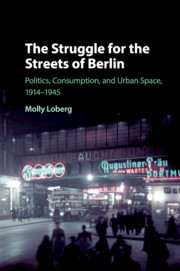The Struggle for the Streets of Berlin Politics, Consumption, and Urban Space, 1914–1945
Langue : Anglais
Auteur : Loberg Molly

Contests over Berlin's streets in the interwar period reveal the fragility of consumer capitalism, urban order, and liberal democracy.
Who owns the street? Interwar Berliners faced this question with great hope yet devastating consequences. In Germany, the First World War and 1918 Revolution transformed the city streets into the most important media for politics and commerce. There, partisans and entrepreneurs fought for the attention of crowds with posters, illuminated advertisements, parades, traffic jams, and violence. The Nazi Party relied on how people already experienced the city to stage aggressive political theater, including the April Boycott and Kristallnacht. Observers in Germany and abroad looked to Berlin's streets to predict the future. They saw dazzling window displays that radiated optimism. They also witnessed crime waves, antisemitic rioting, and failed policing that pointed toward societal collapse. Recognizing the power of urban space, officials pursued increasingly radical policies to 'revitalize' the city, culminating in Albert Speer's plan to eradicate the heart of Berlin and build Germania.
Acknowledgements; List of figures; Introduction: streets of desire and discontent; 1. Paper revolutions: urban advertising in the aftermath of the First World War; 2. Commerce turned inside out: street hawkers, shopkeepers, and the moral geography of consumption during the inflation; 3. Crowd control: traffic, spectacle, and demonstrations during the 'golden twenties'; 4. Fortress shops and militarized streets: looting in depression-era Berlin; 5. When rogues become regulators: 'coordination 'of the streets under the new Nazi regime; 6. Visions of a Nazi world capital: urban 'revitalization' from the Christmas market to Kristallnacht; Epilogue: eradicating Berlin: urban destruction from Germania to the Second World War; Bibliography; Index.
Molly Loberg of California Polytechnic State University, is a Fulbright Scholar and Humboldt Fellow. She has won several awards for her research, including the History Article Prize (2013) from the Berkshire Conference of Women Historians.
Date de parution : 02-2020
Ouvrage de 339 p.
15.3x23 cm
Date de parution : 03-2018
Ouvrage de 338 p.
15.7x23.5 cm
Thème de The Struggle for the Streets of Berlin :
© 2024 LAVOISIER S.A.S.


